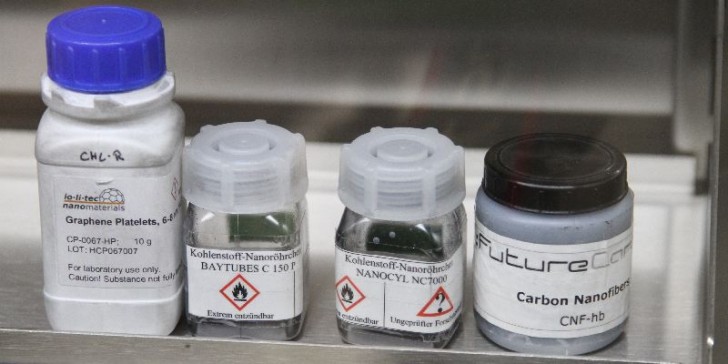Biodistribution of carbon nanotubes in the body

Having perfected an isotope labeling method allowing extremely sensitive detection of carbon nanotubes in living organisms, CEA (Commissariat à l’énergie atomique et aux énergies alternatives) and CNRS (Centre national de la recherche scientifique) researchers have looked at what happens to nanotubes after one year inside an animal. Studies in mice revealed that a very small percentage (0.75%) of the initial quantity of nanotubes inhaled crossed the pulmonary epithelial barrier and translocated to the liver, spleen, and bone marrow. Although these results cannot be extrapolated to humans, this work highlights the importance of developing ultrasensitive methods for assessing the behavior of nanoparticles in animals.
Carbon nanotubes are highly specific nanoparticles with outstanding mechanical and electronic properties that make them suitable for use in a wide range of applications, from structural materials to certain electronic components. Their many present and future uses explain why research teams around the world are now focusing on their impact on human health and the environment.
Researchers from CEA and the CNRS joined forces to study the distribution over time of these nanoparticles in mice, following contamination by inhalation. They combined radiolabeling with radio imaging tools for optimum detection sensitivity. When making the carbon nanotubes, stable carbon (12C) atoms were replaced directly by radioactive carbon (14C) atoms in the very structure of the tubes. This method allows the use of carbon nanotubes similar to those produced in industry, but labeled with 14C. Radio imaging tools make it possible to detect up to twenty or so carbon nanotubes on an animal tissue sample.
A single dose of 20 µg of labeled nanotubes was administered at the start of the protocol, then monitored for one year. The carbon nanotubes were observed to translocate from the lungs to other organs, especially the liver, spleen, and bone marrow. The study demonstrates that these nanoparticles are capable of crossing the pulmonary epithelial barrier, or air-blood barrier. It was also observed that the quantity of carbon nanotubes in these organs rose steadily over time, thus demonstrating that these particles are not eliminated on this timescale. Further studies will have to determine whether this observation remains true beyond a year.
The CEA and CNRS teams have developed highly specific skills that enable them to study the health and environmental impact of nanoparticles from various angles. Nanotoxicology and nanoecotoxicology research such as this is both a priority for society and a scientific challenge, involving experimental approaches and still emerging concepts.
This work is conducted as part of CEA's interdisciplinary Toxicology and Nanosciences programs. These are management, coordination and support structures set up to promote multidisciplinary approaches for studying the potential impact on living organisms of various components of industrial interest, including heavy metals, radionuclides, and new products.
At the CNRS, these concerns are reflected in particular in major initiatives such as the International Consortium for the Environmental Implications of Nano Technology (i-CEINT), a CNRS-led international initiative focusing on the ecotoxicology of nanoparticles. CNRS teams also have a long tradition of close involvement in matters relating to standards and regulations. Examples of this include the ANR NanoNORMA program, led by the CNRS, or ongoing work within the French C'Nano network.
Source: CNRS
Image: © 2014 The Innovation Society Ltd
Cited publication: Czarny, Bertrand, et al. Carbon Nanotube Translocation to Distant Organs after Pulmonary Exposure: Insights from in situ 14C-Radiolabelling and Tissue Radioimaging. ACS nano (2014).
Selected studies on the toxicity of carbon nanotubes:
Poland CA, Duffin R, Kinloch I, Maynard A, Wallace WAH, Seaton A, et al. 2008. Carbon nanotubes introduced into the abdominal cavity of mice show asbestos-like pathogencity in a pilot study. Nat Nanotechnol 3:423–428.
Gasser, Michael, et al. Pulmonary surfactant coating of multi-walled carbon nanotubes (MWCNTs) influences their oxidative and pro-inflammatory potential in vitro. Part Fibre Toxicol 9.1 (2012): 17.